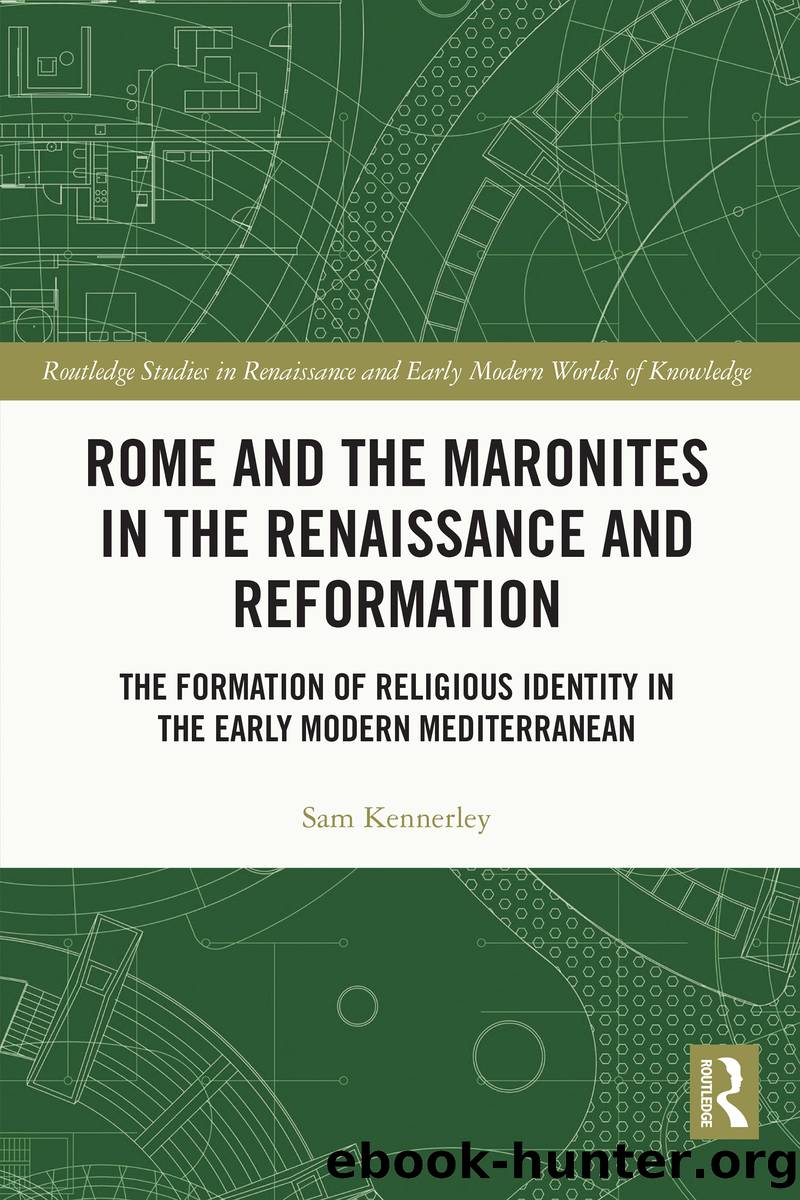Rome and the Maronites in the Renaissance and Reformation by Sam Kennerley;

Author:Sam Kennerley; [Sam, Kennerley]
Language: eng
Format: epub
ISBN: 9781000455816
Publisher: Taylor & Francis (Unlimited)
Published: 2021-07-27T00:00:00+00:00
V. Two Syrian Jacobites in Counter-Reformation Rome: Peter of Damascus and Moses of Mardin
The Jacobite (or Syrian Orthodox) Church derives its name from Jacob Baradeus, a bishop of Edessa who led resistance to the Council of Chalcedon (451) in the Levant during the sixth century. The Jacobites had made contact with Rome during the twelfth century, and, as we saw in Chapter 1, signed what was probably a fleeting union with Rome at the Council of Ferrara-Florence in 1444. But like other eastern Churches, connections between the Jacobites and Rome only intensified from the mid-sixteenth century. Cerviniâs correspondence again provides indispensable material for this history.44
On 18 November 1544, Johann Albrecht von Widmanstetter wrote a despairing letter to Cervini from the Bavarian capital of Landshut. Widmanstetter recounted how a Jacobite deacon named Peter of Damascus had flown into a rage with one of his servants, purchased a two-handed sword, and marched about Landshut threatening to kill some of the townâs inhabitants. The affair was so serious that even Duke Ludwig X of Bavaria became involved. Widmanstetter and the duke managed to calm Peter down and find out what he wanted. Peter demanded the pay that he was due from Widmanstetter, a horse, and spending money for himself and a companion to Rome, all of which were granted. This arrangement would bring to an end Peterâs thoroughly miserable stay in Landshut, which had seen him accuse Widmanstetter of plots against his life, while failing to teach this Orientalist any Arabic. This was despite an agreement to offer such teaching that he had made in Rome with Widmanstetter â and with Cervini.45
Peter of Damascus was not the first eastern Christian to instruct Widmanstetter in the languages of the Levant. This Bavarian Orientalist is regarded as one of the first Europeans to obtain a scholarly knowledge of Syriac and Arabic, much of which he gained during a lengthy stay in Italy between 1527 and 1539.46 Particularly important in this regard was Simeon, the Maronite bishop of Beirut, whom Widmanstetter acknowledged as his âteacherâ.47 We saw in Chapter 2 that the Maronite subdeacon Elias taught Arabic and Syriac to a generation of Catholic Orientalists in the Rome of Leo X. Simeonâs teaching of Widmanstetter, a central figure in the next generation of Catholic Orientalists, further highlights the important role of the Maronites in the early modern history of Orientalist scholarship in the Latin west.
Widmanstetter returned to Rome in October 1543.48 His original intention was to pursue a legal case in the curia, but it was probably on this trip that he met Peter of Damascus. The agreement that Widmanstetter made with Peter in Rome is outlined in his letter to Cervini, where we see that he had agreed to pay Peter 24 scudi a year in exchange for instruction in Arabic. It appears that Cervini was the guarantor of this agreement, as both parties had recourse to his protection once they fell out in 1544. Peter threatened that he would complain to Cervini about the
Download
This site does not store any files on its server. We only index and link to content provided by other sites. Please contact the content providers to delete copyright contents if any and email us, we'll remove relevant links or contents immediately.
Patriot by Alexei Navalny(317)
Museum of Antiquity by T. L. (Thomas Louis) Haines(266)
The Memoirs of Pere Labat, 1693-1705 by Jean Baptiste(225)
Richard III and the Princes in the Tower by A.J. Pollard(217)
The Story of Joan of Arc by Andrew Lang(212)
The Apollo Moon Missions by Randy Walsh(200)
2,2-Dimethyl-3,4-dihydro-2H-1,4-benzoxazines as isosteres of 2,2-dimethylchromans acting as inhibitors of insulin release and vascular smooth muscle relaxants by Bernard Pirotte & Xavier Florence & Eric Goffin & Philippe Lebrun(183)
Fry The Brain: The Art of Urban Sniping and its Role in Modern Guerrilla Warfare by John West(174)
A History of the Peninsular War, Vol. 5, Oct. 1811-Aug. 31, 1812 by Charles Oman(169)
Life of Napoleon Bonaparte, Volume I. by Walter Scott(164)
The Memoirs of Count Grammont â Complete by Hamilton Anthony Count Walter Scott(163)
1916 - The Battle of the Five Empires: 15 May - 28 September 1916 by Benoît Chenu(162)
Maleficium: Witchcraft and Witch Hunting in the West by Gordon Napier(160)
Famous Fights of Indian Native Regiments by Reginald Hodder(151)
Father Browne's Titanic Album by E. E. O'Donnell(140)
Rasputin the Rascal Monk by William Le Queux(138)
BY MARK Twain, Twain - The innocents at home by 1881(138)
The Thoughts of Marcus Aurelius by Marcus Aurelius(134)
Joanna of Flanders by Julie Sarpy(126)
